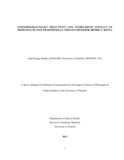| dc.description.abstract | The practice of traditional medicine is as old as the human race and plants are an important source of research and development of new drugs. Anthelmintic resistance in human and animal pathogenic helminths has been spreading in prevalence and severity to a point where there is multi-drug resistance against the three major classes of anthelmintics. It has become a global phenomenon in gastrointestinal nematodes of farm animals, and hence the need for novel anthelmintic products.
The objectives of this study were to document plants which are commonly used in the treatment and control of helminthosis in Loitoktok District of Kenya and to determine the bioactivity, anthelmintic efficacy and preliminary phytochemistry of herbal remedies from selected plants from the study area. An ethnopharmacological study was done through gathering information from 23 traditional health practitioners from across the district. Plants used traditionally as anthelmintics were identified by the traditional healers and samples collected for botanical identification. Sheep belonging to local herders and naturally infected with mixed gastrointestinal nematodes were recruited for the evaluation of anthelmintic efficacy of three herbal remedies Albizia anthelmintica, Embelia schimperi and Myrsine africana remedies were prepared and administered by the methods prescribed by the traditional practitioners. Their efficacy was determined using percentage faecal egg count reduction test (FECRT%). Brine shrimp lethality and the presence of phytochemicals in aqueous and organic extracts were determined. A controlled anthelmintic efficacy study, with sheep artificially infected with mixed gastrointestinal nematodes, was carried out at the Faculty of Veterinary Medicine, University of
xiv
Nairobi. Myrsine africana, Rapanea melanophloeos, Embelia schimperi, Albizia anthelmintica and a combination of A. anthelmintica and R. melanophloeos (1:1) were prepared in versions slightly modified from the traditional ones and their efficacy determined using FECRT, percentage total and differential worm count reduction.
Eighty one medicinal plants were collected and identified as belonging to 46 families. The six most important families by their medicinal use values in decreasing order were Rhamnaceae, Myrsinaceae, Oleaceae, Liliaceae, Usenaceae and Rutaceae. Helminthosis in both livestock and humans was recognized as a major disease managed using medicinal in the study area. The most frequently used plant anthelmintics were Albizia anthelmintica (Fabaceae), Myrsine africana (Myrsinaceae), Rapanea melanophloeos (Myrsinaceae), Embelia schimperi (Myrsinaceae), Clausena anisata (Rutaceae) and Olea africana (Oleaceae) used by 70, 70, 17, 17, 13 and 9 percent of the respondents respectively. The efficacy against gastrointestinal (GI) nematodes in naturally infected sheep was 59, -11, -31 and 87 percent for Myrsine africana, A. anthelmintica, E. schimperi and albendazole respectively. Some of the phytochemicals detected in the extracts were, anthraquinones, flavonoids, glycosides, saponins, steroids, tannins and triterpenoids. Organic extracts were generally more bioactive than the aqueous extracts with LC50 of 11 to 581 μg/ml. and 149 to 1000 μg/ml respectively. The FECR values were 83, 34, 8, -55, 26 and 69 percent for M. africana, R. melanophloeos, E. schimperi, A. anthelmintica, combination of A. anthelmintica and R. melanophloeos, and albendazole respectively. The percentage total worm count reduction was 66, 70, 45, 61 and 55 for M. africana, R. melanophloeos, E. schimperi, A.
xv
anthelmintica and the combination of A. anthelmintica and R. melanophloeos respectively, while albendazole had 35% reduction.
It was concluded that some of the plants used as anthelmintic remedies in Loitoktok contain many types of phytochemicals which could be responsible for their observed bioactivities and anthelmintic properties. However, it is recommended that some of the plants be used cautiously because adverse effects were observed in sheep that were treated with high doses of A. anthelmintica. The Myrsine africana remedy had particularly high efficacy in safe doses against GI nematodes of sheep, and hence merit further study to determine the most optimum dosage, toxicity profiles and determination of the active compound(s) with view of coming up with a novel anthelmintic product. The H. contortus used to artificially infect the sheep in this study were resistant to albendazole and that the M. africana remedy could be further evaluated against such resistant strains of gastrointestinal parasites | en_US |
| dc.description.department | a
Department of Psychiatry, University of Nairobi, ; bDepartment of Mental Health, School of Medicine,
Moi University, Eldoret, Kenya | |

